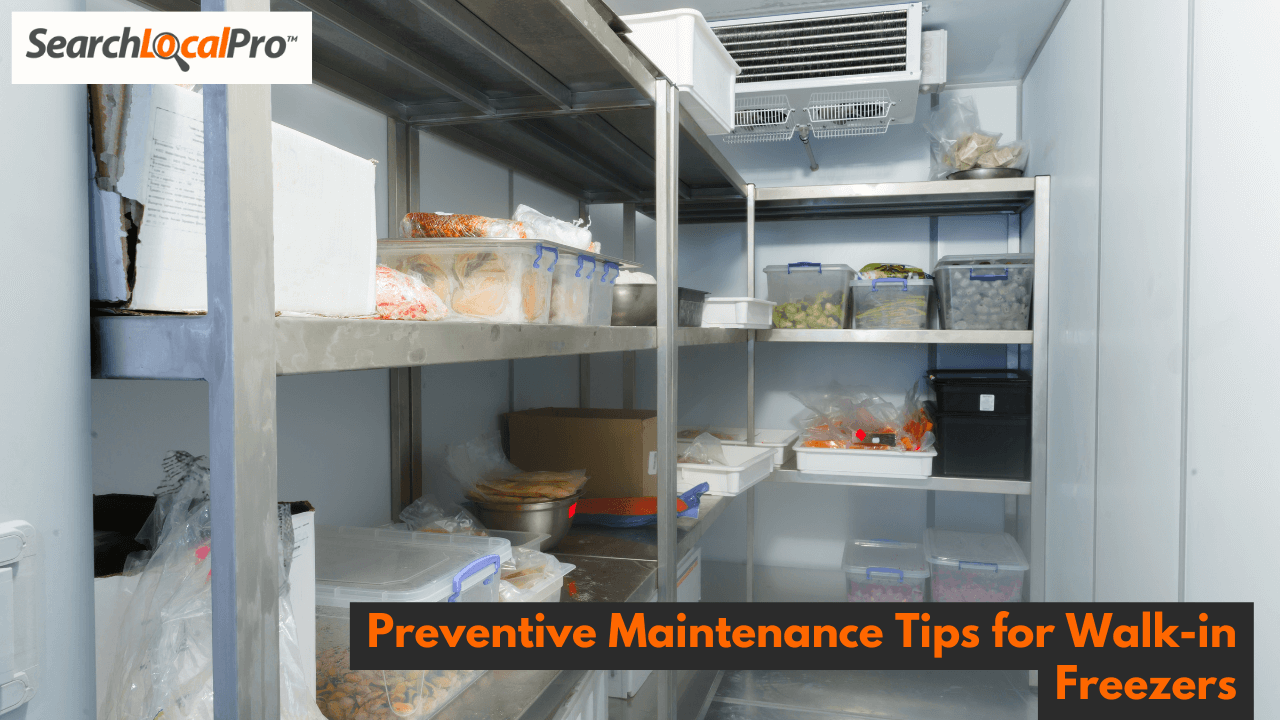Walk-in freezers are the unsung heroes of countless industries, diligently maintaining the perfect temperature for food preservation, scientific experiments, and various other applications. But just like any hardworking machine, they require proper care to function optimally. Here’s where preventive maintenance tips for walk-in freezers come into play.
By implementing a consistent and effective maintenance routine, you can ensure your walk-in freezer operates efficiently, saving you money on energy bills and repairs. More importantly, you’ll safeguard the integrity of your stored items, preventing spoilage or compromised quality.
This comprehensive guide dives deep into the world of walk-in freezer maintenance, empowering you to become a pro .
Why Prevention Maintenance For Walk in Freezers Matter?
Imagine this: you reach for a box of frozen ingredients, only to discover the walk-in freezer has malfunctioned, leaving your stock at risk. This scenario highlights the importance of preventive maintenance tips for walk-in freezers.
Regular maintenance isn’t just about preventing costly breakdowns; it’s about optimizing performance. A well-maintained walk-in freezer operates efficiently, using less energy to maintain the desired temperature. This translates to lower utility bills and a reduced environmental footprint.
Furthermore, consistent maintenance helps ensure consistent temperatures within the freezer. This is crucial for maintaining food safety and preserving the quality of your stored items. Fluctuating temperatures can accelerate spoilage, leading to product loss and potential health risks.
Here’s a breakdown of the key benefits of prioritizing preventive maintenance tips for walk-in freezers:
- Reduced risk of breakdowns: Catching minor issues early on prevents them from snowballing into major repairs.
- Enhanced efficiency: A well-maintained freezer uses less energy to maintain temperature.
- Improved food safety: Consistent temperatures minimize the risk of spoilage and ensure food quality.
- Extended lifespan: Proper care increases the longevity of your walk-in freezer.
- Peace of mind: Knowing your freezer is in top shape provides peace of mind and allows you to focus on your core business.
By dedicating time to preventive maintenance tips for walk-in freezers, you’re making a wise investment that pays off in the long run.
Preventive Maintenance Tips for Walk-in Freezers Checklist: A Step-by-Step Guide
Now that we’ve established the significance of preventive maintenance tips for walk-in freezers, let’s delve into the specifics. This checklist outlines a comprehensive approach to keeping your walk-in freezer in peak condition:
1. Temperature Monitoring:
- Invest in a reliable thermometer specifically designed for freezer use.
- Regularly monitor the temperature within the freezer, aiming for the manufacturer’s recommended range.
- Record the readings to identify any fluctuations that might require investigation.
- A slight temperature rise could indicate a malfunctioning defrost cycle, clogged condenser coils, or a faulty door seal. Prompt action can prevent product spoilage and costly repairs.
2. Cleaning and Sanitation:
- Maintain a clean and sanitary environment within the freezer to prevent the growth of bacteria and mold.
- Schedule regular cleaning sessions, typically once a month for low-traffic freezers and more frequently for high-traffic units.
- Turn off the freezer and remove all contents before cleaning.
- Use warm water and a mild detergent solution to wipe down all surfaces, including walls, floors, shelves, and door gaskets.
- Rinse thoroughly with clean water and allow everything to dry completely before restarting the freezer.
- Pay particular attention to areas prone to moisture buildup, such as corners and around the door frame.
3. Condenser Coil Care:
- The condenser coils are responsible for releasing heat from the freezer. Dust and debris buildup on these coils can significantly hinder their performance.
- At least once a quarter, clean the condenser coils using a soft brush or vacuum cleaner.
- Be gentle to avoid damaging the delicate fins.
- Ensure proper airflow around the condenser unit by removing any obstructions near the vents.
4. Defrost Cycle Inspection:
- Most walk-in freezers have an automatic defrost cycle that prevents excessive ice buildup on the evaporator coils.
- Regularly check the defrost cycle to ensure it’s functioning properly.
- Signs of a malfunctioning defrost cycle include: excessive ice buildup on the coils, uneven cooling within the freezer, and increased energy consumption.
- If you suspect an issue with the defrost cycle, consult a qualified technician for repair.
5. Door Gasket Inspection:
- The door gasket is a vital component that creates a tight seal, preventing warm air from entering the freezer and maintaining consistent temperatures.
- Regularly inspect the door gasket for signs of wear and tear, such as cracks, tears, or loss.
- Loss of elasticity. A worn-out gasket won’t form a proper seal, leading to inefficient operation and increased energy consumption.
- To test the seal, place a dollar bill halfway between the door and the frame. If you can easily pull the bill out without resistance, the gasket needs replacing.
- Replace a damaged door gasket promptly to maintain optimal performance and energy efficiency.
6. Fan Maintenance:
- The evaporator and condenser fans play a crucial role in circulating air within the freezer.
- Regularly inspect the fans for any obstructions, such as dust buildup or debris.
- Clean the fans with a soft brush or vacuum cleaner.
- Check the fan blades for damage or wear and tear. Replace any damaged blades to ensure proper airflow.
- Listen for any unusual noises coming from the fans, which could indicate a failing motor that needs attention.
7. Lighting Check:
- Proper lighting is essential for ensuring safe and efficient operation within the walk-in freezer.
- Replace burned-out bulbs promptly to maintain adequate visibility and prevent accidents.
- Consider using LED bulbs, which offer superior energy efficiency and a longer lifespan compared to traditional incandescent bulbs.
8. Inventory Management:
- Proper inventory management practices can contribute to efficient freezer operation.
- Avoid overcrowding the freezer, as this can hinder air circulation and impact temperature control.
- Strategically organize your stored items to allow for proper airflow and easy access.
- Implement a first-in, first-out (FIFO) inventory system to minimize the risk of older products expiring at the back of the freezer.
9. Record Keeping:
- Maintain a detailed logbook to document your preventive maintenance tips for walk-in freezers.
- Record the date and time of each maintenance activity, along with any observations or actions taken.
- Note down the temperature readings, cleaning procedures performed, and any repairs or replacements made.
- A well-maintained logbook provides a valuable historical record and helps identify potential issues before they escalate.
10. Professional Service:
- Schedule regular professional walk in freezer maintenance checkups by a qualified technician. Ideally, this should be done annually or as recommended by the manufacturer.
- A professional technician can perform a comprehensive inspection of your walk-in freezer, identifying any potential problems and addressing them before they become major issues.
- They can also provide valuable insights and recommendations for optimizing your freezer’s performance and efficiency.
By following these preventive maintenance tips for walk-in freezers, you can ensure your frosty companion operates smoothly and efficiently for years to come. Remember, a well-maintained walk-in freezer not only saves you money but also safeguards the integrity of your stored products, promoting food safety and quality control. Embrace a proactive approach to maintenance, and your walk-in freezer will continue to be a reliable asset for your business.




